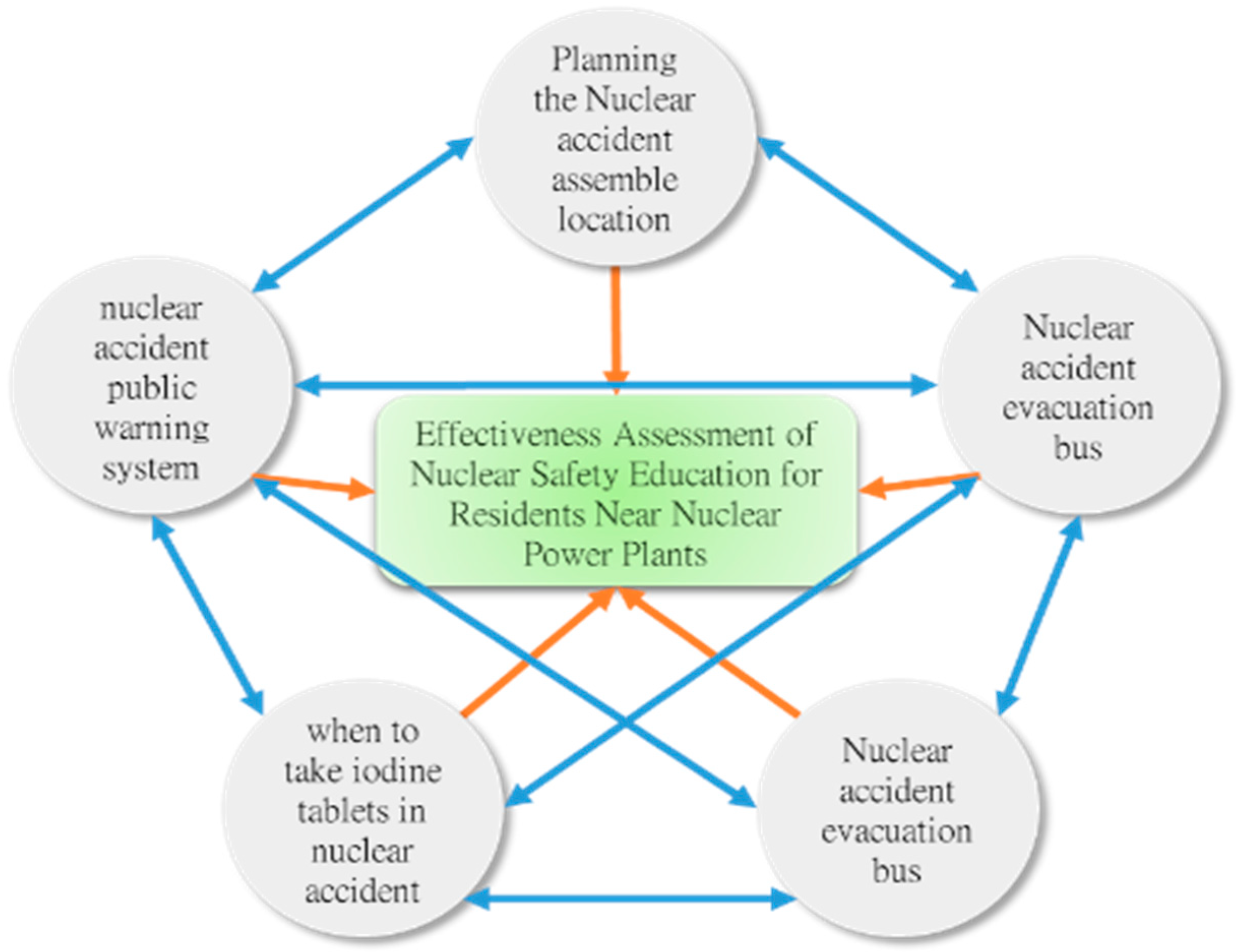Disaster Response System Dynamic Assessment Model Based on Questionnaire Investigation: A Case Study of Nuclear Accident Preparedness Education †
Abstract
1. Introduction
2. Materials and Methods
2.1. Questionnaire Design
2.2. Data Processing and Analysis
2.3. System Dynamics Assessment Model
3. Results and Discussion
3.1. Demographic Variables and Participation Experience Analysis
3.2. Bivariate Analysis of Training Benefits
3.3. Prediction and Analysis of Nuclear Safety Evacuation Exercise
3.4. System Dynamics Evaluation
3.5. Discussion
4. Conclusions
Author Contributions
Funding
Institutional Review Board Statement
Informed Consent Statement
Data Availability Statement
Conflicts of Interest
References
- International Atomic Energy Agency. Nuclear Power Status Worldwide-2022; IAEA Annual Report; IAEA: Vienna, Austria, 2022. [Google Scholar]
- Yim, M.S.; Vaganov, P.A. Effects of education on nuclear risk perception and attitude: Theory. Prog. Nucl. Energy 2023, 42, 221–235. [Google Scholar] [CrossRef]
- Tsai, M.H.; Chang, Y.L.; Shiau, J.S.; Wang, S.M. Exploring the effects of a serious game-based learning package for disaster prevention education: The case of battle of flooding protection. Int. J. Disaster Risk Reduct. 2020, 43, 101393. [Google Scholar] [CrossRef]
- Huang, Y.P.; Wei, H.W.; Chen, T.Y.; Jhang, N.Y.; Chen, C.; Cheng, Y.C.; Yang, C.W.; Shih, W.K. The effectiveness of integrating somatosensory technology into nuclear energy education learning. Procedia Soc. Behav. Sci. 2015, 176, 476–482. [Google Scholar] [CrossRef]
- Han, E.O.; Kim, J.R.; Choi, Y.S. Korean student’ behavioral change toward nuclear power generation through education. Nucl. Eng. Technol. 2014, 46, 707–718. [Google Scholar] [CrossRef]
- Seddighi, H.; Lopez, M.L.; Zwitter, A.; Muldoon, M.L.; Sajjadi, H.; Yousefzadeh, S. Non-formal disaster education programs for school students in Iran: A qualitative study of the challenges experienced by stakeholders. Int. J. Disaster Risk Reduct. 2023, 86, 103531. [Google Scholar] [CrossRef]
- Shaw, R.; Mallick, F.; Takeuchi, Y. Essentials of higher education in disaster risk reduction: Prospects and challenges. Community Environ. Disaster Risk Manag. 2011, 7, 95–113. [Google Scholar]
- Ismail-Zadeh, A.T.; Cutter, S.L.; Takeuchi, K.; Paton, D. Forging a paradigm shift in disaster science. Nat. Hazards 2017, 86, 969–988. [Google Scholar] [CrossRef]

| Item | Course Content | Comprehension Level of Nuclear Safety Education and Training Courses |
|---|---|---|
| 1 | Knowing the nuclear accident public warning system | Do you know the nuclear accident siren? |
| 2 | Planning the nuclear accident assemble location and functions | Do you know the public assembly location of nuclear accidents? |
| 3 | Nuclear accident evacuation bus and route planning | Do you know how to take the nuclear accident evacuation buses? |
| 4 | The plan for nuclear accident’s public evacuation shelters | Do you know the plan of nuclear accident evacuation shelters for people? |
| 5 | Who and when to take iodine tablets in a nuclear accident | Do you know the standard for taking iodine tablets during a nuclear accident? |
| Variables | Nuclear Safety Education and Training Experience (Number of Times) | Variables | Nuclear Safety Evacuation Exercise Experience (Number of Times) |
|---|---|---|---|
| χ2 | χ2 | ||
| Gender | 1.555 | Gender | 7.120 |
| Age | 28.432 ** | Age | 28.336 ** |
| occupation | 13.853 | occupation | 25.784 * |
| Education level | 14.794 * | Education level | 14.794 * |
| Gender | 1.555 | Gender | 7.120 |
| Mean | Standard Deviation | Standard Error | 95% CI | t-Value | Degree of Freedom | Significance |
|---|---|---|---|---|---|---|
| −1.540 | 1.400 | 0.082 | [−1.701, −1.378] | −18.760 | 290 | 0.000 *** |
| Model 1 | Model 2 | |||||
|---|---|---|---|---|---|---|
| B | SE B | β | B | SE B | β | |
| Constant | 1.045 | 0.274 | 0.189 | 0.210 | ||
| Gender | −0.091 | 0.122 | −0.048 | 0.006 | 0.091 | 0.003 |
| Age | 0.185 | 0.050 | 0.225 *** | 0.081 | 0.037 | 0.099 * |
| Occupation | 0.068 | 0.122 | 0.037 | −0.037 | 0.091 | −0.020 |
| Education level | −0.072 | 0.076 | −0.057 | −0.097 | 0.056 | −0.077 |
| Training experience | 0.645 | 0.042 | 0.667 *** | |||
| R2 | 0.059 | 0.488 | 0.059 | 0.488 | 0.059 | 0.488 |
| Adj R2 | 0.046 | 0.479 | 0.046 | 0.479 | 0.046 | 0.479 |
| F for change in R2 | 4.502 ** | 54.242 *** | 4.502 ** | 54.242 *** | 4.502 ** | 54.242 *** |
Disclaimer/Publisher’s Note: The statements, opinions and data contained in all publications are solely those of the individual author(s) and contributor(s) and not of MDPI and/or the editor(s). MDPI and/or the editor(s) disclaim responsibility for any injury to people or property resulting from any ideas, methods, instructions or products referred to in the content. |
© 2025 by the authors. Licensee MDPI, Basel, Switzerland. This article is an open access article distributed under the terms and conditions of the Creative Commons Attribution (CC BY) license (https://creativecommons.org/licenses/by/4.0/).
Share and Cite
Wu, C.-Y.; Yeh, Y.-L. Disaster Response System Dynamic Assessment Model Based on Questionnaire Investigation: A Case Study of Nuclear Accident Preparedness Education. Eng. Proc. 2025, 89, 6. https://doi.org/10.3390/engproc2025089006
Wu C-Y, Yeh Y-L. Disaster Response System Dynamic Assessment Model Based on Questionnaire Investigation: A Case Study of Nuclear Accident Preparedness Education. Engineering Proceedings. 2025; 89(1):6. https://doi.org/10.3390/engproc2025089006
Chicago/Turabian StyleWu, Ching-Yi, and Yi-Lung Yeh. 2025. "Disaster Response System Dynamic Assessment Model Based on Questionnaire Investigation: A Case Study of Nuclear Accident Preparedness Education" Engineering Proceedings 89, no. 1: 6. https://doi.org/10.3390/engproc2025089006
APA StyleWu, C.-Y., & Yeh, Y.-L. (2025). Disaster Response System Dynamic Assessment Model Based on Questionnaire Investigation: A Case Study of Nuclear Accident Preparedness Education. Engineering Proceedings, 89(1), 6. https://doi.org/10.3390/engproc2025089006





